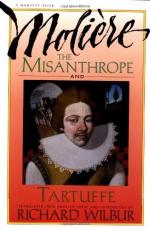|
This section contains 5,694 words (approx. 19 pages at 300 words per page) |

|
SOURCE: “Caractères, Superstition and Paradoxes in Le Misanthrope,” in Alteratives, edited by Warren Motte and Gerald Prince, French Forum Publishers, 1993, pp. 71-84.
In this essay, Gaines argues that the series of oppositions and dualities in The Misanthrope comprise a deliberate pattern of paradoxes.
Beginning with Rousseau's Lettre à d'Alembert and continuing through modern studies by Jules Brody and others,1 it has been common critical practice to analyze Le Misanthrope as a system of conflicting dualities: Alceste against the rest of the characters, sincerity versus dissimulation, ethical versus esthetic principles, homme de bien versus honnêtes hommes. This tradition of analysis by antinomies is carried to a ridiculous extreme in Fabre d'Eglantine's drama of the revolutionary era, Le Philinte de Molière, where the evil aristocrat Philinte is righteously chastised for his dissembling by an anti-establishment Alceste.2
From the perspective of language, however, the binary tradition does not provide...
|
This section contains 5,694 words (approx. 19 pages at 300 words per page) |

|


